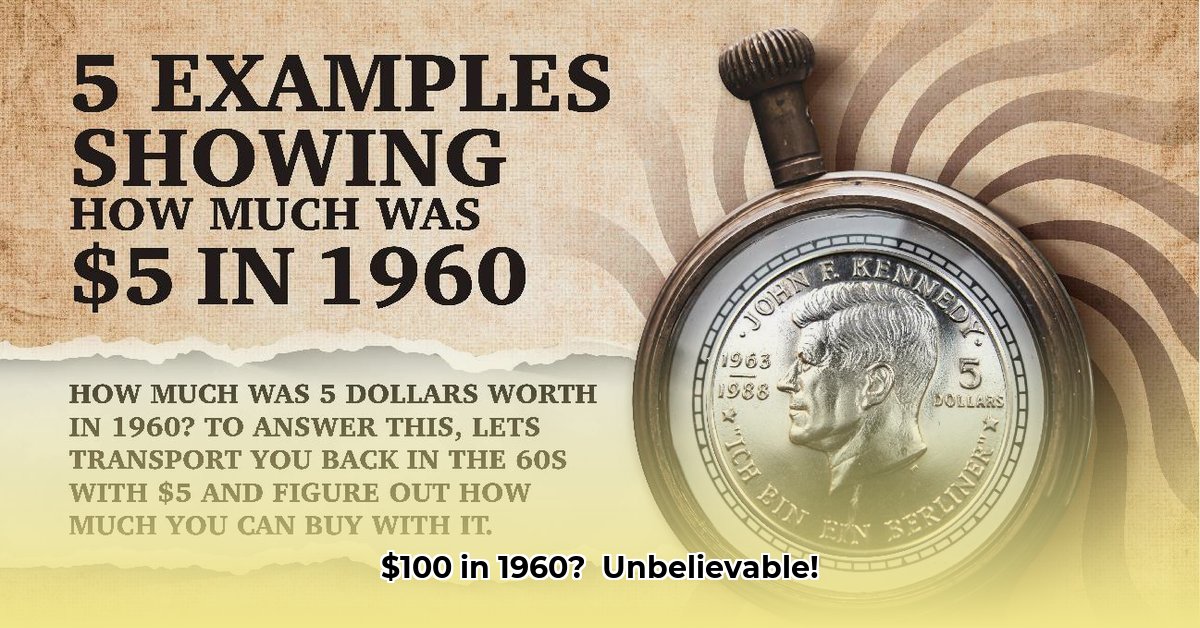
Imagine buying a brand new car in 1960 for $100. Sounds unbelievable, right? Today, that same car would cost you well over a thousand dollars. This startling reality underscores the dramatic impact of inflation over time. This article explores the surprising difference in purchasing power between a 1960 dollar and its 2025 equivalent, providing insights into inflation's effects on personal finance and economic policy.
How Much Was $100 Worth in 1960?
Stepping back in time to 1960 with a hundred-dollar bill would have afforded a drastically different level of purchasing power than it does today. What could you have bought? While a new car or house was likely out of reach, considerable everyday purchases were within reach. This disparity illustrates the insidious erosion of the dollar's value due to inflation.
Understanding Inflation: The Silent Thief of Purchasing Power
Inflation is the gradual increase in the general price level of goods and services in an economy over a period of time. Think of it as a silent thief, steadily diminishing the buying power of your money. If a gallon of milk cost $0.50 in 1960 and costs $4 today, that's inflation in action. Your money simply doesn't stretch as far as it once did.
Deciphering the 1960 Dollar: The Numbers Revealed
Economists use the Consumer Price Index (CPI) – a measure that tracks changes in the price of a basket of goods and services – to compare purchasing power across time. Based on CPI data, $100 in 1960 held roughly the same buying power as approximately $1,070 in 2025. This represents a substantial increase, highlighting an average annual inflation rate of around 3.7% over this period. Why aren't all calculations identical? Minor variations arise from differences in data sets and rounding methods used in the calculations. However, the substantial loss of purchasing power remains consistent across estimations.
A 1960 Shopping Spree: A Look Back
To truly appreciate this difference, consider what $100 could buy in 1960. It might have covered a significant portion of monthly rent, filled your gas tank multiple times, or provided a week's worth of groceries for a family. This stark contrast to present-day purchasing power emphasizes the dramatic effect of inflation. How much would those same goods cost today? Substantially more.
Inflation's Impact: Who Feels the Pinch?
Inflation’s consequences are far-reaching and unevenly distributed. Consider these impacted groups:
- Individual Investors: Inflation makes saving and investment planning more challenging because returns must outpace inflation to maintain real value.
- Pensioners/Retirement Savers: Retirement savings are particularly vulnerable when inflation erodes returns. Careful financial planning is critical.
- Government Policy Makers: Responsible for employing fiscal and monetary policies aimed at controlling inflation and stabilizing the economy.
- Businesses: Companies must adapt pricing and production costs to remain profitable, or risk losing competitiveness.
Did you know that even minor differences in inflation rates can dramatically impact long-term savings? A seemingly small difference of 1% annually can significantly affect the growth of an investment over several decades.
Navigating Inflation: Protecting Your Financial Future
The massive shift in the dollar's value between 1960 and today serves as a powerful lesson in the long-term impact of inflation. Understanding its effects is crucial for sound financial decision-making. Whether you are saving for a down payment, investing for retirement, or simply managing a budget, factoring in inflation is essential. Ignoring it can lead to significant shortfalls in meeting financial goals. Staying informed about inflation trends and economic forecasts can significantly enhance your financial preparedness.
Key Takeaways:
- Inflation significantly erodes the purchasing power of money over time.
- $100 in 1960 is equivalent to roughly $1070 in 2025, due to the effects of inflation.
- Understanding inflation is vital for effective personal finance and economic policy.